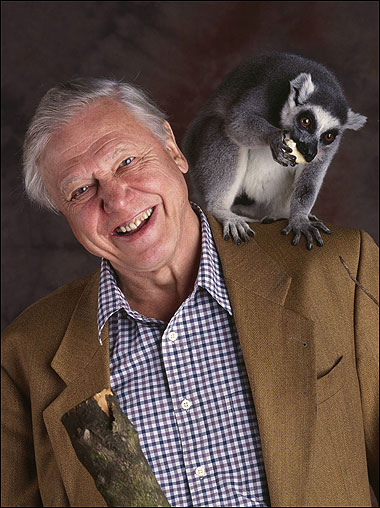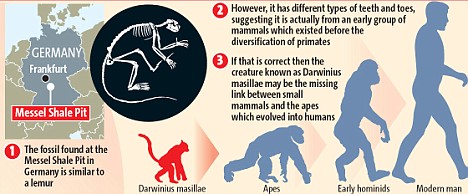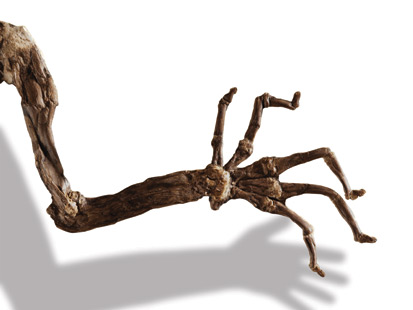May 20, 2009
Missing Link Ida: Media Darling

Ida, properly known as Darwinius masillae, is the 47-million-year-old fossil, said to be a critical “missing link” species in primate evolution. As you may have noticed, this little fossil has been all over the news. I’ve gotten so many emails about it, I get it that people want to talk about it.
Would Darwin have cared? Is this more hype than reality?
Unfortunately, I think it may be a moment of mere media madness, drummed up by a bit of scientific marketing driven along by the use, once again, of the word “missing link.” My use of “missing link” in my headline is a jest, to make my point.
“This is the first link to all humans,” said paleontologist Jörn H. Hurum of the Natural History Museum in Oslo, Norway, who lead the team that found the fossil. Ida represents “the closest thing we can get to a direct ancestor.”
Hurm has a very sexy new website, documentary, and book to assist him in his promotional campaign.

The documentary’s host is Sir David Attenborough, here with a lemur. The BBC documentary, Uncovering Our Earliest Ancestor: The Link will be on BBC1 and History on May 25-26, 2009.

Aegyptopithecus, the “Dawn Ape” is seen as the inheritor of traits perhaps first found in Darwinius masillae.
The Darwinius masillae specimen was excavated by private collectors in 1983 from the Messel Shale Pit, a shale quarry near Darmstadt, Germany, that has yielded many fossils of Eocene life, including other primitive primates.
Hurum said the site was “one of the real treasure troves of paleontology, like the Gobi Desert for dinosaurs.”
“This specimen looks like a really early fossil monkey that belongs to the group that includes us,” said Brian Richmond, a biological anthropologist at George Washington University in Washington, D.C. “[Ida] is one of the important branching points on the evolutionary tree, but it’s not the only branching point.”

I really like what the blogger at “A Primate of Modern Aspect” writes about how one newspaper treated this latest news of a “missing link”: ” A rather annoying graphic shows our new little fossil evolving directly into an ape, skipping all the really interesting and diverse animals in between. Animals like Aegyptopithecus, Eosimias, Proconsul, and Oreopithecus.”
Dr. Jens Franzen, an expert on the Messel Pit and a member of the team, described Ida (a bit over the top to the BBC News) as “like the Eighth Wonder of the World,” because of the extraordinary completeness of the skeleton.
It was information “palaeontologists can normally only dream of,” he said.
In addition, Ida bears “a close resemblance to ourselves” he said, with nails instead of claws, a grasping hand and an opposable thumb – like humans and some other primates. But he said some aspects of the teeth indicate she is not a direct ancestor – more of an “aunt” than a “grandmother.”

The fossil has opposable thumbs, similar to humans’, and fingernails instead of claws.
“She belongs to the group from which higher primates and human beings developed but my impression is she is not on the direct line,” Franzen conceded.
Independent experts are keen to see the new fossil but somewhat skeptical of any claim that it could be “a missing link.”
“I actually don’t think it’s terribly close to the common ancestral line of monkeys, apes and people,” said K. Christopher Beard of the Carnegie Museum of Natural History in Pittsburgh. “I would say it’s about as far away as you can get from that line and still be a primate.”
Rather than a long-ago aunt, “I would say it’s more like a third cousin twice removed,” he said. So it probably resembles ancestral creatures “only in a very peripheral way,” he said.
Beard said scientists already have a fossil from China of about the same age that is widely accepted as coming from monkey-ape-human ancestral line, and it’s much smaller than the new-found fossil and ate a different diet. “They are radically different animals,” he said.
John Fleagle of the State University of New York at Stony Brook said the scientists’ analysis provides only “a pretty weak link” between the new creature and higher primates, called anthropoids, that includes monkeys and man.
“It doesn’t really tell us much about anthropoid origins, quite frankly,” Fleagle said.
Fleagle said the scientists did an “extraordinary” job of extracting detailed information from the fossil. “There’s certainly a lot more information about this individual than probably any other fossil primate that’s ever been recovered,” he said.
Dr. Henry Gee, a senior editor at the journal Nature, said the term itself was misleading and that the scientific community would need to evaluate its significance.
“It’s extremely nice to have a new find and it will be well-studied,” Gee said. But he added that it was not likely to be in the same league as major discoveries such as “Flores man” or feathered dinosaurs.
Indeed.
 About Loren Coleman
About Loren Coleman
Loren Coleman is one of the world’s leading cryptozoologists, some say “the” leading living cryptozoologist. Certainly, he is acknowledged as the current living American researcher and writer who has most popularized cryptozoology in the late 20th and early 21st centuries.
Starting his fieldwork and investigations in 1960, after traveling and trekking extensively in pursuit of cryptozoological mysteries, Coleman began writing to share his experiences in 1969. An honorary member of Ivan T. Sanderson’s Society for the Investigation of the Unexplained in the 1970s, Coleman has been bestowed with similar honorary memberships of the North Idaho College Cryptozoology Club in 1983, and in subsequent years, that of the British Columbia Scientific Cryptozoology Club, CryptoSafari International, and other international organizations. He was also a Life Member and Benefactor of the International Society of Cryptozoology (now-defunct).
Loren Coleman’s daily blog, as a member of the Cryptomundo Team, served as an ongoing avenue of communication for the ever-growing body of cryptozoo news from 2005 through 2013. He returned as an infrequent contributor beginning Halloween week of 2015.
Coleman is the founder in 2003, and current director of the International Cryptozoology Museum in Portland, Maine.
Email • Facebook • Twitter •
Filed under Breaking News, CryptoZoo News, Extinct, Fossil Finds, Weird Animal News





